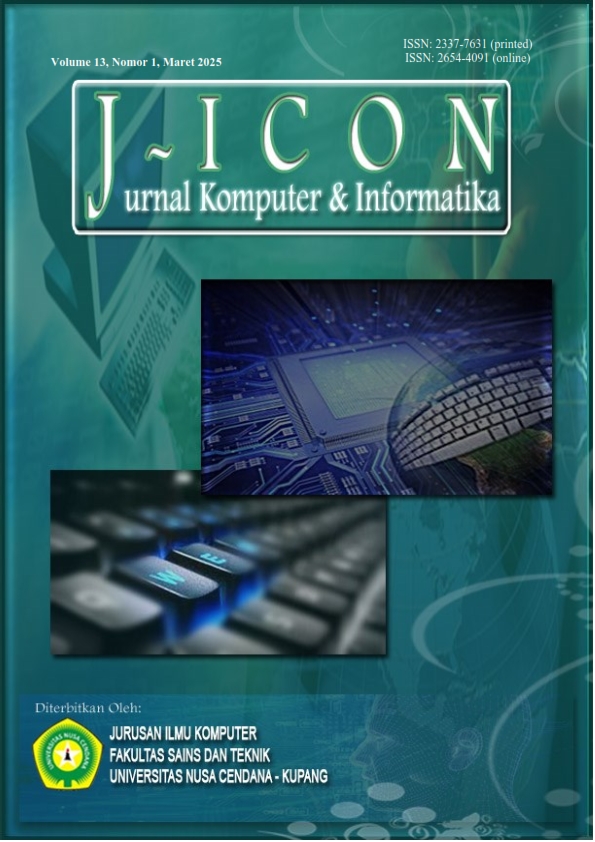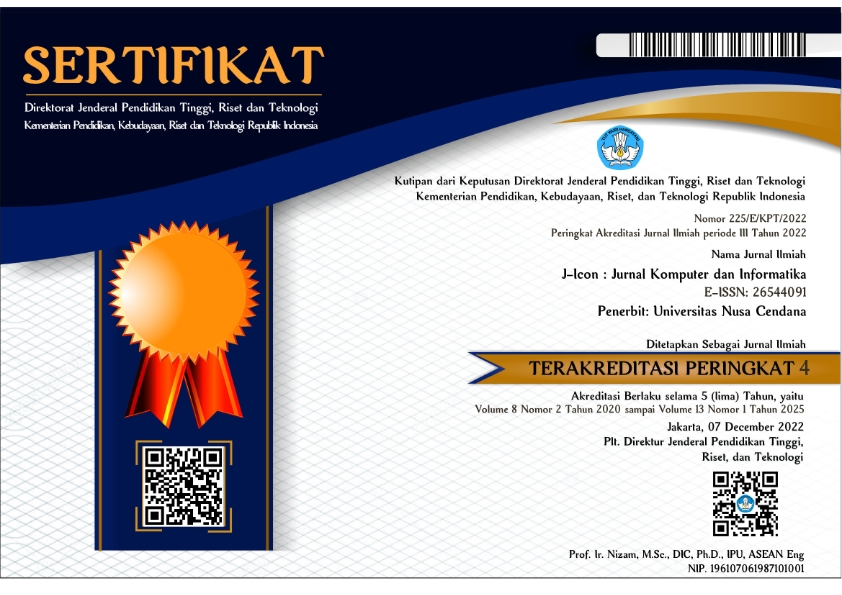USE OF UI/X ON WEBSITE RECOMMENDATION OF LAPTOP SPECIFICATIONS WITH K-MEANS ALGORITHM
Abstract
The process of choosing a laptop that suits their needs is often a challenge for consumers because of the variety of specifications and features offered. Many consumers find it difficult to make the right choice, especially because the information available is often not well structured. In addition, each individual's needs vary, ranging from use for daily productivity to special needs such as gaming or graphic design. Therefore, this study aims to develop a prototype design of a laptop recommendation system using the K-Means clustering algorithm, which is able to group laptop specification data into certain clusters based on the similarity of features. A total of 25 laptop specification data were used in this analysis, with the main parameters being RAM capacity and SSD capacity. The data was processed using the data mining method, and the K-Means algorithm was applied to perform grouping. The optimal number of clusters is determined using the elbow method to ensure accurate and relevant results. The results of the grouping show that laptops can be classified into specific groups that represent consumer needs, such as use for daily productivity or high-load work. The prototype design of this system was created using Figma to visualize an intuitive and easy-to-use user interface (UI). With this prototype design, it is hoped that it can be a reference in the development of a system that makes it easier for consumers to choose a laptop that suits their preferences and needs.
Downloads
References
[2] Utomo, D. P., & Purba, B. (2019). Penerapan Datamining pada Data Gempa Bumi Terhadap Potensi Tsunami di Indonesia. Prosiding Seminar Nasional Riset Information Science (SENARIS), 1(February), 846. https://doi.org/10.30645/senaris.v1i0.91
[3] Nasari, F., & Darma, S. (2015). Penerapan K-Means Clustering Pada Data Penerimaan Mahasiswa Baru (Studi Kasus : Universitas Potensi Utama). 6–8.
[4] Putri Riyandoro, A., Voutama, A., & Umaidah, Y. (2023). Implementasi Data Mining Clustering K-Means Dalam Menggolongkan Beragam Merek Laptop. JATI (Jurnal Mahasiswa Teknik Informatika), 7(2), 1372–1377. https://doi.org/10.36040/jati.v7i2.6816
[5] Mardi, Y. (2017). Data Mining : Klasifikasi Menggunakan Algoritma C4.5. Edik Informatika, 2(2), 213–219. https://doi.org/10.22202/ei.2016.v2i2.1465
[6] Baginda, B. (2023). Implementasi Data Mining Dalam Pemilihan Laptop Berbasis Algoritma C4.5 Pada Software WEKA. Jurnal Minfo Polgan, 12(1), 1065–1073. https://doi.org/10.33395/jmp.v12i1.12582
[7] Muhammad Arhami, S. S. M. K., & Muhammad Nasir, S. T. M. T. (2020). Data Mining - Algoritma dan Implementasi. Andi Offset. https://books.google.co.id/books?id=AtcCEAAAQBAJ
[8] Sari, R. M., Rizka, A., Putri, N. A., & Efriana, A. (2024). Perhitungan Metode Clustering. Serasi Media Teknologi. https://books.google.co.id/books?id=RIU0EQAAQBAJ
[9] Kambey, G. E. I., Sengkey, R., & Jacobus, A. (2020). Penerapan Clustering pada Aplikasi Pendeteksi Kemiripan Dokumen Teks Bahasa Indonesia. Jurnal Teknik Informatika, 15(2), 75–82.
[10] Darmi, Y. D., & Setiawan, A. (2017). Penerapan Metode Clustering K-Means Dalam Pengelompokan Penjualan Produk. Jurnal Media Infotama, 12(2), 148–157. https://doi.org/10.37676/jmi.v12i2.418
[11] Priyatman, H., Sajid, F., & Haldivany, D. (2019). Klasterisasi Menggunakan Algoritma K-Means Clustering untuk Memprediksi Waktu Kelulusan Mahasiswa. Jurnal Edukasi Dan Penelitian Informatika, 5(1), 62–66.
[12] Isa, I. G. T., Elfaladonna, F., & Ariyanti, I. (2022). Buku Ajar Sistem Pendukung Keputusan. Penerbit NEM. https://books.google.co.id/books?id=aCJsEAAAQBAJ
[13] Prianto, C., & Bunyamin, S. (2020). Pembuatan aplikasi clustering gangguan jaringan menggunakan metode K-Means clustering. Kreatif. https://books.google.co.id/books?id=y8TgDwAAQBAJ
[14] Metisen, B. M., & Sari, H. L. (2015). Analisis clustering menggunakan metode K-Means dalam pengelompokkan penjualan produk pada Swalayan Fadhila. Jurnal Media Infotama, 11(2), 110–118.
[15] NURHAYATI. (2022). PEMODELAN K- MEANS ALGORITMA DAN BIG DATA ANALYSIS (PEMETAAN DATA MUSTAHIQ). Pascal Books. https://books.google.co.id/books?id=_bJmEAAAQBAJ
Copyright (c) 2025 Susliansyah Susliansyah

This work is licensed under a Creative Commons Attribution 4.0 International License.
The author submitting the manuscript must understand and agree that if accepted for publication, authors retain copyright and grant the journal right of first publication with the work simultaneously licensed under a Creative Commons Attribution (CC-BY) 4.0 License that allows others to share the work with an acknowledgment of the work’s authorship and initial publication in this journal.
 Susliansyah Susliansyah(1*)
Susliansyah Susliansyah(1*)




